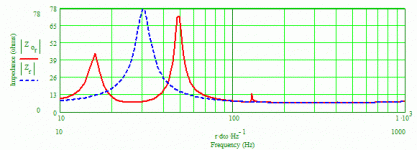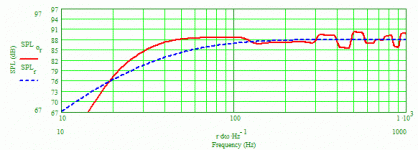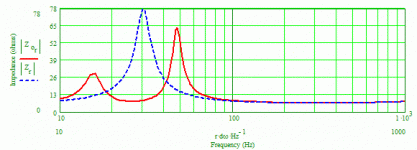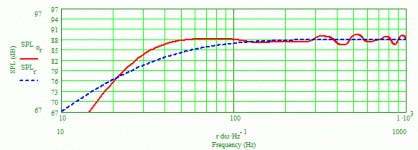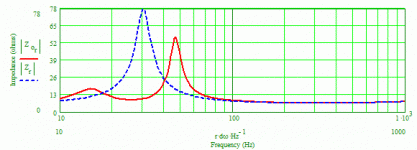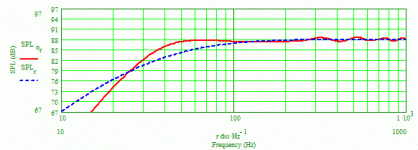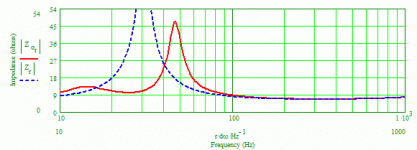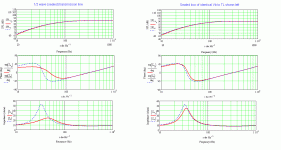Dr.EM
Yes! You were thinking directly along the lines of Hegeman et al. Each subsequent peak is attacked with yet another closed end tuned pipe. IIRC, Mr. Morton's sub utilized 4 tuned lengths which were then de-Q'd with damping (he used sponges from Ace Hardware.) I recall that up to 6 tubes have been used. At the higher frequencies, the resonant tubes are sufficiently low Q to avoid serious rippling effects. The Hegeman speakers are two way so the woofer indeed handled frequencies well into mid frequencies. I've auditioned them before and they sound really nice.
In the chapter entitled "Acoustic Elements" of Leo Beranek's "Acoustics" textbook, the closed tube acoustic impedance is described as a function of frequency given in terms of tube length, tube volume and cross sectional area. Mr. Morton's article translates the theory into practical calculations.
Mr. Morton is a retired engineer from Motorola here in Phoenix, and just happens to be in our local audio club, so we have been priveleged to follow his experiments closely. I somehow ended up with one of his 12" subs when he was clearing out his garage. The box is large, but the sound is tight.
Bill
Yes! You were thinking directly along the lines of Hegeman et al. Each subsequent peak is attacked with yet another closed end tuned pipe. IIRC, Mr. Morton's sub utilized 4 tuned lengths which were then de-Q'd with damping (he used sponges from Ace Hardware.) I recall that up to 6 tubes have been used. At the higher frequencies, the resonant tubes are sufficiently low Q to avoid serious rippling effects. The Hegeman speakers are two way so the woofer indeed handled frequencies well into mid frequencies. I've auditioned them before and they sound really nice.
In the chapter entitled "Acoustic Elements" of Leo Beranek's "Acoustics" textbook, the closed tube acoustic impedance is described as a function of frequency given in terms of tube length, tube volume and cross sectional area. Mr. Morton's article translates the theory into practical calculations.
Mr. Morton is a retired engineer from Motorola here in Phoenix, and just happens to be in our local audio club, so we have been priveleged to follow his experiments closely. I somehow ended up with one of his 12" subs when he was clearing out his garage. The box is large, but the sound is tight.
Bill
Dr. EM-
Could you measure frequency response of your system with and without stuffing? Around the resonance frequency of the driver, I believe that an increase of current drawn would correlate to reduced excursion of the driver's cone. That would further indicate a drop in sound pressure level at fundamental resonance (equals Fs), I would think.
If the above is correct, and you are closing both ends of the TL, then stuffing would be advised to flatten frequency response. That is, you would want to eliminate the fundamental resonance of the pipe.
Regards,
Pete
Could you measure frequency response of your system with and without stuffing? Around the resonance frequency of the driver, I believe that an increase of current drawn would correlate to reduced excursion of the driver's cone. That would further indicate a drop in sound pressure level at fundamental resonance (equals Fs), I would think.
If the above is correct, and you are closing both ends of the TL, then stuffing would be advised to flatten frequency response. That is, you would want to eliminate the fundamental resonance of the pipe.
Regards,
Pete
Stuffing effects examples
Primarily for my own edification, and for anyone else if interested, I modeled a tapered TL for an SS18W/8531. It's 72 inches long, is tapered at 10:1 and contains a volume of ~1.7 cubic feet. Starting off with no stuffing, I've attached two graphs, the overall system response and the impedance curve. Following those two graphs are 3 more pairs of graphs (in separate posts if necessary). The line was stuffed for the first 2/3 of its length at 0.25, 0.5 and 1.0 lb/ft3, respectively. If you "measure" the line's resonant frequency based on the frequency of the valley between the two impedance peaks, there is very little decrease shown as I see on the graphs. The graphs need to be "read" from left to right starting on the top row to get the right sequence.
Paul
Primarily for my own edification, and for anyone else if interested, I modeled a tapered TL for an SS18W/8531. It's 72 inches long, is tapered at 10:1 and contains a volume of ~1.7 cubic feet. Starting off with no stuffing, I've attached two graphs, the overall system response and the impedance curve. Following those two graphs are 3 more pairs of graphs (in separate posts if necessary). The line was stuffed for the first 2/3 of its length at 0.25, 0.5 and 1.0 lb/ft3, respectively. If you "measure" the line's resonant frequency based on the frequency of the valley between the two impedance peaks, there is very little decrease shown as I see on the graphs. The graphs need to be "read" from left to right starting on the top row to get the right sequence.
Paul
A drop from 400 to 300 is more than a third of an octave. I have to assume that the same relationships would hold true no matter what length (frequency) line you were working with.
David S.
Attachments
Last edited:
Would moving the driver down a closed TL line by say, 20 % make any difference? I have heard in open TLs this is beneficial but I don't know if this works the same way in a closed..
Also, how does this affect the overall length?
Also, how does this affect the overall length?
I made some quick frequency response measures, these are close to the driver (4-5") and are ungated, 12th octave smoothed.
Clear ripples in the response can be seen in the unstuffed (red) example. This is what I would expect.
An externally hosted image should be here but it was not working when we last tested it.
Clear ripples in the response can be seen in the unstuffed (red) example. This is what I would expect.
To flatten out the impedance you need to have good acoustic load at the resonance frequency.
Damping causes also a acoutic load only one you do not want. It is a dissipative acoustic load it only puts a brake on the cone of your driver.
So you do not have to think in TL or BR or horn or open baffle. But in acoustic load for your cone-driver.
A BR is a closed box with a BR-port that ads extra acoustic load at the resonance frequency.
all this is a great perspective to view things from.
it makes me think what a dual chamber BR could do...one chamber tuned to the higher of the impedance peaks caused by the main tuning frequency, and damp them a little with stuffing.....
or a multipath reflx tuned TQWT
Last edited:
I know nobody is listening when I say it (again), but length only matters on a closed end pipe if you have no stuffing. Once you add sufficient stuffing then the length becomes immaterial.
Look at Dr. Em's curves. How much of that near 15dB response hole do you want? Do you want to trade a 15dB hole for a "flattened" impedance curve? Probably not, so stuff it until all reflections are gone and...why did we make it 1/2 wave long?
David S.
Look at Dr. Em's curves. How much of that near 15dB response hole do you want? Do you want to trade a 15dB hole for a "flattened" impedance curve? Probably not, so stuff it until all reflections are gone and...why did we make it 1/2 wave long?
David S.
...why did we make it 1/2 wave long?
So that the lowest frequency of interest has to pass thru at least 1 wavelength of damping before it reaches the back of the cone.
dave
In the same "spirit" as this post from you, I noticed you never responded to my post above about stuffing effects which clearly shows that stuffing has decreasing effects on lowering the tuning frequency as frequency becomes lower and lower, far less than the 25% reduction on 400 Hz and the 20% reduction on 100 Hz examples you cited. You incorrectly concluded (assumed, actually) that lower frequencies would be affected about the same percentages when, in fact, in the 20-30 Hz range, it's more like 10%, and becomes less at even lower frequencies. There's no mystery to this because, after all, stuffing is an acoustical low-pass filter and behaves just like an electrical low-pass filter; as frequency goes down, attenuation decreases.
Paul
Paul
I know nobody is listening when I say it (again), but length only matters on a closed end pipe if you have no stuffing. Once you add sufficient stuffing then the length becomes immaterial.
Look at Dr. Em's curves. How much of that near 15dB response hole do you want? Do you want to trade a 15dB hole for a "flattened" impedance curve? Probably not, so stuff it until all reflections are gone and...why did we make it 1/2 wave long?
David S.
There are many ways to acoustically flattening the impedance.
Below is a "varidamp" design crudely made.
Another way is the "symmetric air friction" design, not specifically tuned for the target driver.
The The "Elsinore Project" defines a great criteria on defining which frequency to tune for.
Below is a "varidamp" design crudely made.
An externally hosted image should be here but it was not working when we last tested it.
Another way is the "symmetric air friction" design, not specifically tuned for the target driver.
An externally hosted image should be here but it was not working when we last tested it.
The The "Elsinore Project" defines a great criteria on defining which frequency to tune for.
Last edited:
In the same "spirit" as this post from you, I noticed you never responded to my post above about stuffing effects which clearly shows that stuffing has decreasing effects on lowering the tuning frequency as frequency becomes lower and lower, far less than the 25% reduction on 400 Hz and the 20% reduction on 100 Hz examples you cited. You incorrectly concluded (assumed, actually) that lower frequencies would be affected about the same percentages when, in fact, in the 20-30 Hz range, it's more like 10%, and becomes less at even lower frequencies. There's no mystery to this because, after all, stuffing is an acoustical low-pass filter and behaves just like an electrical low-pass filter; as frequency goes down, attenuation decreases.
Paul
I can't vouch one way or the other about the accuracy of your model. I was refering to the very clear evidence of the series of measurements that Augspurger made. He built up a sample line and varied the stuffing density with the results that I quoted, that characteristic frequencies dropped considerably with increased stuffing. I reject your notion that all the effects wouldn't scale with line size. "As frequency goes down, attenuation decreases" would be offset by the longer line having proportionately greater length of stuffing.
Regarding: "pass(ing) thru at least 1 wavelength of damping before it reaches the back of the cone." I didn't know that was a requirement. If we have a 40Hz tone generated in a bookshelf speaker there won't be one wavelength (or 1/2 wavelength) of stuffing inside that cabinet at 40 Hz. It won't matter. What we really need is adequate damping for the higher frequencies of actual cabinet resonances.
As much as people get excited about 1/4 and 1/2 wave lines they are badly resonant systems when undamped and just stuffed boxes when damped enough to kill the resonances. Can anyone give any evidence that a well damped 1/2 wave line is any different than a similarly stuffed enclosure of any other shape and the same volume?
David S.
So that the lowest frequency of interest has to pass thru at least 1 wavelength of damping before it reaches the back of the cone.
dave
I would take this as a conclusion from this. The 1/2 wave TL is relevant loading for, particularly, a midrange driver, but the length is fairly immaterial it's just likely you'll want about 1/2 wavelength to ensure you damp frequencies down to driver resonance. If you were crossing a driver (mid, tweet) over much higher than resonance you could, by the same measure, use a shorter TL.
It seems than any driver mounted in a highly stuffed enclosure will exhibit a flattened impedance, the TL just forces the backwave to travel through the absorbent material. The B&W website states that up to a frequency where the diameter of the tube becomes comparable to the wavelength of the backwave the sound will travel as a planar wave along the tube and so must pass through the stuffing.
As Helmhulth states, using all this stuffing does just "put a brake" on cone movement, it's not doing anything useful with it, we're not gaining any efficiency by doing this. However, for a midrange this might be quite useful where the primary concern is clarity.
As much as people get excited about 1/4 and 1/2 wave lines they are badly resonant systems when undamped...
If you say 'resonant' rather than 'badly resonant', then I'd agree. Why they have suddenly become automatically 'bad', even when properly designed, is mysterious.
Can anyone give any evidence that a well damped 1/2 wave line is any different than a similarly stuffed enclosure of any other shape and the same volume?
Er, yes. See the attached. One half wave TL (as in a sealed, damped pipe with a physical length of 1/2 Fs) on the left. On the right, a sealed box with the same driver of the same total Vb with exactly the same quantity of damping.
Attachments
Last edited:
The sound must pass through the stuffing no matter what the shape of the enclosure. It passes through the stuffing in all directions until it is dissipated. If it makes it back to the cone then you can detect an effect externally. If it doesn't make it back to the cone then the shape of the box (TL or not) is no longer relevant.I would take this as a conclusion from this. The 1/2 wave TL is relevant loading for, particularly, a midrange driver, but the length is fairly immaterial it's just likely you'll want about 1/2 wavelength to ensure you damp frequencies down to driver resonance. If you were crossing a driver (mid, tweet) over much higher than resonance you could, by the same measure, use a shorter TL.
It seems than any driver mounted in a highly stuffed enclosure will exhibit a flattened impedance, the TL just forces the backwave to travel through the absorbent material. The B&W website states that up to a frequency where the diameter of the tube becomes comparable to the wavelength of the backwave the sound will travel as a planar wave along the tube and so must pass through the stuffing.
As Helmhulth states, using all this stuffing does just "put a brake" on cone movement, it's not doing anything useful with it, we're not gaining any efficiency by doing this. However, for a midrange this might be quite useful where the primary concern is clarity.
There is no brake applied in the well damped case. Dr. Em's curves show what putting a brake on cone motion results in: a 15dB hole in response. Clearly this is undesirable. If you don't want that hole you apply damping. Killing the resonance equates to losing the braking. We can't have it both ways.
All enclosures, when undamped are highly resonant. Just like mini listening rooms they have all the lengthwise, tangential and oblique modes of a domestic room. Applying damping to a good percentage of each dimension (getting away from the high pressure, low velocity boundaries) is all we need to do to kill the resonances. Once the cavity is well damped there are no after effects from its particular shape.
David
If you say 'resonant' rather than 'badly resonant', then I'd agree. Why they have suddenly become automatically 'bad', even when properly designed, is mysterious.
I would again refer to Dr. Em's curves. What amount of the response resonances would be good? I'd guess not the full 15dB. 5dB? 3dB? It is taken as a given that enclosure resonances are undesirable.
If I put a midrange in a typical squarish enclosure and see the usual length (and width and height) resonances, I would want to damp them out. Giving the enclosure an unusual depth, i.e. making it a "TL", doesn't make the resonances good.
Er, yes. See the attached. One half wave TL (as in a sealed, damped pipe with a physical length of 1/2 Fs) on the left. On the right, a sealed box with the same driver of the same total Vb with exactly the same quantity of damping.
Here I will concede that you have reduced Z at resonance (from 45 to 25 ohms) with no apparent response effects. I could put an impedance conjugate across the driver and flatten it perfectly. Probably an acoustic resistance blanket across the unit would do the same. What was the benefit? Is this what the TL is all about?
David
The sound must pass through the stuffing no matter what the shape of the enclosure. It passes through the stuffing in all directions until it is dissipated. If it makes it back to the cone then you can detect an effect externally. If it doesn't make it back to the cone then the shape of the box (TL or not) is no longer relevant.
David
This makes sense- and if tuned correctly it directly controls xmax i think
just would like to know if the driver benefits from being placed a set distance down the line (or not) ..anyone? closed and open may be different
Last edited:
All enclosures, when undamped are highly resonant. Just like mini listening rooms they have all the lengthwise, tangential and oblique modes of a domestic room. Applying damping to a good percentage of each dimension (getting away from the high pressure, low velocity boundaries) is all we need to do to kill the resonances. Once the cavity is well damped there are no after effects from its particular shape.
David
thanks for posting that great simmed response Scott. clear to see that both the phase response at lower freqs, and the impedance curve are considerably improved, so with respect to as best as i can see the identical SPL responses, the closed TL is superior in every other way.
and as the other poster commented:
all shapes have a resonance 'profile'. stretch one dimension too far and its a pipe, whether its tapered bent or stuffed, and will act as such. the reflection in a 1/4 line will still have the 'reflex' effect, until such time that the stuffing can attenuate, or slurr the pressure wave sufficiently. the traditional acoustic law in room acoustics ie either 1/4 or 1/2 WL i can never remember, and attenuation due to the absroption coeffiecent of the material. its simple math really, if i can find it in my pile of books ill do the calcs lol, but im pretty sure that for say 40 hz you wont get total absorption for more than 1 wavelength., and probably several or many wavelengths. the best result would be got from composite, graduated density fillings, with different characteristics, if near total(total) backwave elimination was desired. even a heavily stuffed TL will see SOME damping due to pressure backwave type reflex effect, but its Q if you like is reduced and the peak gain also levelled out lower.
Last edited:
You're welcome.
Personally, I'd take the TL also, but horses for courses.
Ah, you were talking expressly about midrange lines rather than in blanket terms. Yes, certainly no disagreement on that score.
Agreed. If there were, it would be poorly designed and therefore from my POV unfit for purpose.
Your point is?
They'll get you some of the way there, but certainly not entirely. Their heyday was in pre T/S reflex cabinets where they could help damp down excessive output at Fb.
Assuming we're staying with sealed midrange lines, you've seen a sub-optimal example already (sub optimal because I can't be bothered on Christmas eve to spend time designing an optimal one for what I I assume are obvious reasons unrelated to audio). What we have with a damped plane-wave tube is an acoustic solution to an acoustic problem, your damped tube as Keele, Kolbrek &c. note closely approximating the resistive load impedance of an infinite pipe, the constant, frequency independant load thus behaving in a fashion analogous to a 'perfect' horn. Very useful both for testing compression drivers, and for loading midrange units. Yes, there are alternatives. Are they as effective (or more so), acoustically? Sometimes yes, sometimes no. There are no black or white solutions in audio; it would be arrogant (and foolish) in the extreme to suggest there were.
Personally, I'd take the TL also, but horses for courses.
If I put a midrange in a typical squarish enclosure and see the usual length (and width and height) resonances, I would want to damp them out. Giving the enclosure an unusual depth, i.e. making it a "TL", doesn't make the resonances good.
Ah, you were talking expressly about midrange lines rather than in blanket terms. Yes, certainly no disagreement on that score.
Here I will concede that you have reduced Z at resonance (from 45 to 25 ohms) with no apparent response effects.
Agreed. If there were, it would be poorly designed and therefore from my POV unfit for purpose.
I could put an impedance conjugate across the driver and flatten it perfectly.
Your point is?
Probably an acoustic resistance blanket across the unit would do the same.
They'll get you some of the way there, but certainly not entirely. Their heyday was in pre T/S reflex cabinets where they could help damp down excessive output at Fb.
What was the benefit? Is this what the TL is all about?
Assuming we're staying with sealed midrange lines, you've seen a sub-optimal example already (sub optimal because I can't be bothered on Christmas eve to spend time designing an optimal one for what I I assume are obvious reasons unrelated to audio). What we have with a damped plane-wave tube is an acoustic solution to an acoustic problem, your damped tube as Keele, Kolbrek &c. note closely approximating the resistive load impedance of an infinite pipe, the constant, frequency independant load thus behaving in a fashion analogous to a 'perfect' horn. Very useful both for testing compression drivers, and for loading midrange units. Yes, there are alternatives. Are they as effective (or more so), acoustically? Sometimes yes, sometimes no. There are no black or white solutions in audio; it would be arrogant (and foolish) in the extreme to suggest there were.
Last edited:
following that thought it seems to me that MAYBE, big maybe, IF you make a tapered line 10:1 or more(!) and stuff it, and compare to an expanding line of identical tuning and reverse ratio (1:10 or more(!)) and stuff it similarly, results due to the reflected presssure wave may be quite different. 2nd thoughts couldnt i just move the driver to the other end of the line? hmm......ah no the length....
i would envision using an expanding line closed as a 1/2 wave TL for a midrange or FR in a FAST type idea. i could be totally wrong, but left 1/4 stuffed, i think port output and its bandwidth would be radically different. and the same lines closed and stuffed maybe also. id expect an expanding closed tl to dissipate more energy before the boundary reflection, and depsite being 'funnelled' back up in pressure, and not least due to the extra length required. i feel maybe less would reach the cone than a tapered type.
i would envision using an expanding line closed as a 1/2 wave TL for a midrange or FR in a FAST type idea. i could be totally wrong, but left 1/4 stuffed, i think port output and its bandwidth would be radically different. and the same lines closed and stuffed maybe also. id expect an expanding closed tl to dissipate more energy before the boundary reflection, and depsite being 'funnelled' back up in pressure, and not least due to the extra length required. i feel maybe less would reach the cone than a tapered type.
Last edited:
- Status
- Not open for further replies.
- Home
- Loudspeakers
- Multi-Way
- Closed end TL experiments, impedance flattening

